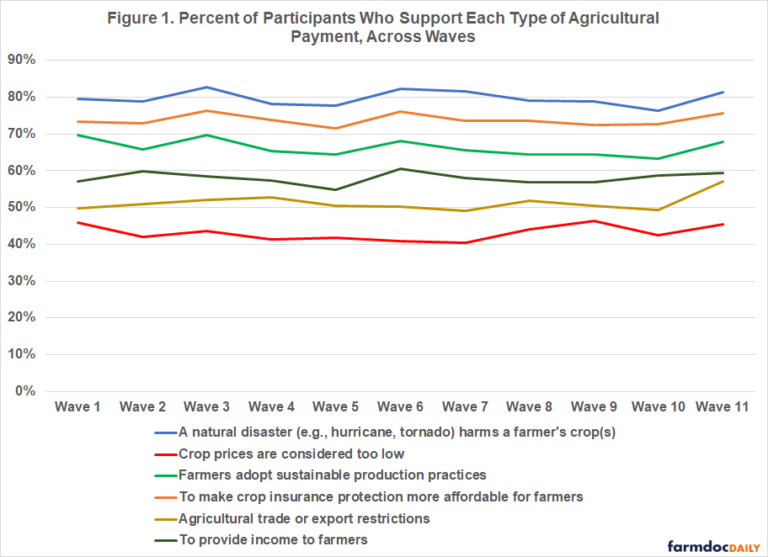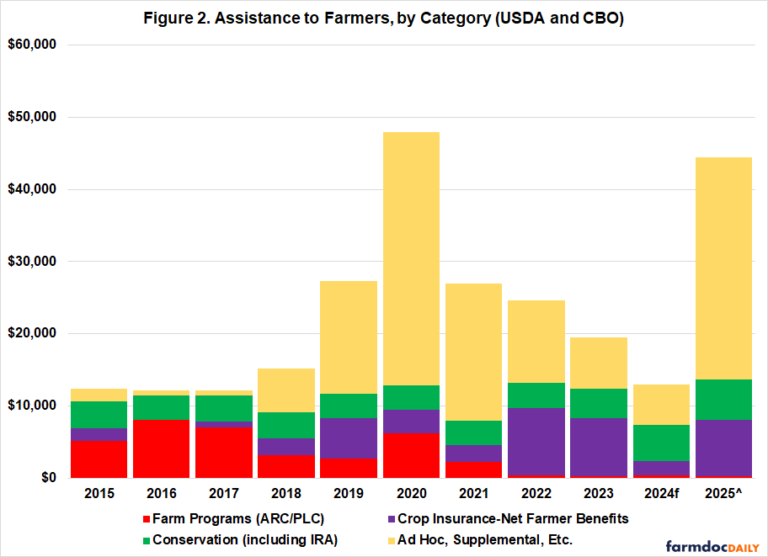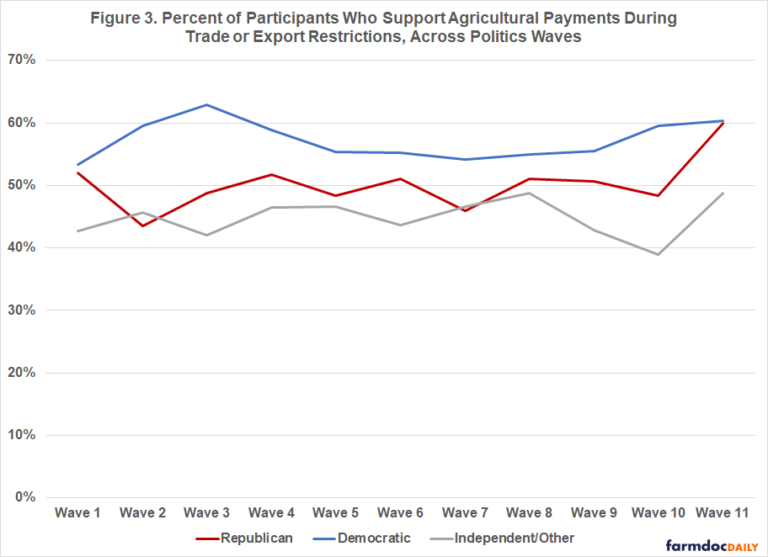By Jonathan Coppess and Maria Kalaitzandonakes et.al
Introduction
The final action of the 118th Congress was to enact a continuing resolution to fund the federal government through March 14, 2025. The legislation also extended the 2018 Farm Bill for another year through the 2025 crop and fiscal years. Finally, the bill provided supplemental appropriations for disaster relief. Included in this supplemental appropriation was $30.78 billion in assistance to farmers, of which $10 billion is for “economic assistance” designed to make direct payments for economic losses based on the lower crop price projections and the rest in response to natural disasters (P.L. 118-158; see also, farmdoc daily, January 7, 2025; MPRNews, December 22, 2024; Blankenship, November 18, 2024). Extension of the Farm Bill for another year, rather than a full five-year reauthorization, coupled with another round of supplemental assistance to farmers and a change in administration, present many questions for farm policy (see e.g., farmdoc daily, December 13, 2024; November 13, 2024; October 30, 2024).
With those questions in mind, this article reviews public support for payments to farmers. The public – in their roles as taxpayers, voters, and consumers – are important stakeholders in agricultural policy. Here, we discuss results from the eleven waves of the Gardner Food and Agricultural Policy Survey, which has tracked public support for a variety of situations when farmers might receive financial support from the government, including during the 2024 presidential election.
Our results show that the public has been broadly supportive of both payments following natural disasters and payments to subsidize crop insurance across time. Payments triggered by low crop prices have continued to have the lowest levels of support. Interestingly, while payments for farmers during export or trade restrictions has generally been relatively low across time, support for the payments rose in November 2024, perhaps driven by the increased salience of potential tariffs during the presidential campaign.
Methods
In this post we utilize results from the eleven waves of the Gardner Food and Agricultural Policy Survey (GFAPS). The survey has been conducted quarterly from May 2022 to November 2024 (which was conducted in the days following the 2024 presidential election). Approximately 1,000 U.S. consumers are recruited each wave to match the U.S. population in terms of gender, age, household income, and geographic region.
Survey participants were asked whether the government should provide financial support to farmers in six different potential situations: (1) a natural disaster (e.g., hurricane, tornado) harms a farmer’s crop(s), (2) crop prices are considered too low, (3) farmers adopt sustainable production practices, (4) to make crop insurance protection more affordable for farmers, (5) agricultural trade or export restrictions, (6) to provide income to farmers. The order of the situations was randomized to prevent ordering effects.
Results
For nearly three years, GFAPS has been tracking public support for different types of agricultural payments. The discussion that follows reviews two aspects of the findings during these eleven survey waves. First is a review of the overall responses and trends for payments to farmers. The responses over time add perspective to the recent supplemental payments. Second the discussion takes a closer look at support for payments due to trade conflicts in anticipation of the potential for additional tariffs and trade conflict in the second Trump Administration.
(1) Reviewing Public Support for Payments to Farmers
Figure 1 illustrates the GFAPS survey findings for payments to farmers since May 2022, including the most recent results collected following the 2024 elections. Responses have been generally consistent throughout the entire timeframe. The strongest support has consistently been payments for farmers in response to natural disasters, averaging 80% across all eleven waves. By comparison, the weakest support has consistently been for payments when crop prices are considered too low, averaging 43% across all eleven waves.

These results are particularly notable in light of the supplemental assistance enacted by the lame duck 118th Congress. Roughly one-third of the funds ($10 billion) are for economic assistance payments to farmers. These payments are in response to lower crop prices in the fall (which has lower public support), coupled with increased costs in recent years. The remaining two-thirds ($20.1 billion) of the funds are for assistance in response to natural disasters (which has high public support), especially the devastation caused by hurricanes in the fall.
Figure 2 provides additional perspective, showing actual payments to farmers since 2015 reported by USDA, as well as USDA and Congressional Budget Office forecasts for payments in 2024 and 2025 (USDA-ERS, “Data Files: U.S. and State-Level Farm Income and Wealth Statistics,” updated December 3, 2024; CBO, June 2024). The bars use colors to show the types of payments: red indicates farm programs (ARC/PLC), purple shows crop insurance net farmer benefits, green shows conservation (including IRA), and yellow shows ad hoc/supplemental payments. It also includes the net farmer benefit from crop insurance (total indemnities minus farmer-paid premium), which was calculated using the Summary of Business data (USDA-RMA, Summary of Business).

While the public is broadly supportive of providing many types of financial support to farmers, most are unfamiliar with the Farm Bill or the specifics of the programs (Center for Food Demand Analysis & Sustainability, 2024). Previous research has shown that public support for payments is driven primarily by the public’s desire to have a stable, national food supply (Ellison, Lusk, and Briggeman, 2010). However, the public generally underestimates the income of farmers and the size of support payments farmers are given (Ellison, Lusk, and Briggeman, 2010; farmdoc daily, April 6, 2023). Comparing Figures 1 and 2 provides some measure of how close payments align with public support and three initial takeaways for further consideration:
- Among all payments to farmers, the ad hoc, supplemental, etc. payments are the most difficult to compare; as in the most recent $30 billion supplemental appropriation, such assistance can be in response to natural disasters (highly supported by the public) but also can be in response to lower crop prices or trade conflicts (lower public support);since 2018, these payments have experienced an extraordinary increase in response to previous trade conflicts and the pandemic.
- Assistance from conservation programs (green bars) would align with the third-highest category of public support in the survey (support for adopting sustainable farming practices) and that assistance has been relatively consistent since 2015, with some increase in 2023 and 2024 from the Inflation Reduction Act of 2022.
- Crop insurance (purple) has the second highest level of support and net farmer benefits have been mostly higher in recent years, while farm program payments (ARC/PLC; red bars) are generally in response to lower crop prices (lowest levels of public support) and provide income to farmers (third lowest). These payments have trended down in recent years with relatively higher crop prices, while Congress has been unable to reauthorize the Farm Bill or revise these programs.
(2) A Closer Look at Support for Payment Farmers During Trade Conflicts
As can be seen in Figure 1, the most recent wave (11), which was conducted in the days after the 2024 presidential election, saw a noticeable uptick in support for payments in response to trade or export restrictions compared to the previous waves.
In the previous ten waves, support for payments to farmers during trade or export restrictions averaged 51% with the highest level of support at 53% in wave 4 (see Figure 1). Following the 2024 presidential election, however, support for these payments increased to 57% of participants. This was an 8-point increase from the previous wave and 6 points above the average of the previous ten waves.
It seems likely that the increase in support is driven at least in part by the increased saliency of the tariff issues associated with Donald Trump’s second presidency. For example, Google Trends shows that the search term “tariff” increased substantially in October and November of this year (Google Trends, 2024). In both campaign and post-election speeches, Trump has indicated he will levy a 10-20% tariff on all imported goods and a 60% tariff on Chinese imports, and some of the recent cabinet nominations brought reports of increased concern surrounding agricultural ‘trade wars’ (e.g., Wiesemeyer, 2024).
While it is unclear how these promises will play out during the second Trump presidency (e.g., betting markets have expressed doubt that tariffs will be implemented (Polymarket, 2024)), there is precedent. During his first presidential term, Trump instituted tariffs, emphasizing imports from China. The impacts were felt almost immediately in agriculture as the tariffs and retaliation from China initially harmed crop prices, especially for soybeans. In response, the Trump Administration issued over $20 billion in ad hoc payments known as Market Facilitation Program payments to offset the costs. Indeed, research has found that payments given to farmers did exceed the losses related to the tariffs on average, though this varied across commodity and farm size (Janzen and Hendricks, 2020). Whether or not tariffs will return remains to be seen; however, reports from agricultural organizations suggest that if they do, analysts expect them to have impacts on agriculture again (e.g., Swanson, Gerlt, and Holland, 2024).
The recent change in public support for payments during export or trade restrictions was noticeably partisan. Figure 3 shows the proportion of participants who indicated they were Republican, Democratic, or Independent/Other that supported this type of payment in each wave. We find that the increase in support seems to have come from those identifying as Republicans, as Democratic participants have been more supportive of these types of payments across waves overall. We also received an uptick in support for these payments from those identifying as independent or other, similar to the increase in support from Republicans. In November, about 60% of both Democratic and Republican participants and 49% of Independent/Other participants supported payments to farmers affected by export or trade restrictions. Again, it seems likely that this change may be driven by saliency, as for example, Republican participants may have been more likely to hear Republican news sources discussing Donald Trump’s proposed tariffs and the expected impact on agriculture.

Conclusion
The GFAPS has been tracking public support for a variety of agricultural payment types for nearly three years. Public support for farm payments has renewed relevance with the $30 billion in supplemental assistance enacted by the lame duck 118th Congress and with a second Donald Trump presidency around the corner.
Results from the GFAPS show that the public is most supportive of payments following natural disasters and least supportive of payments in response to low crop prices. Interestingly, support for payments for farmers following export or trade restrictions saw an uptick in November, following the election. The increase in support was driven by changes in perceptions of Republican and Independent/Other participants, as Democratic participants had long had higher levels of support for these types of payments. It seems likely that these changes were driven by increased saliency of the issue during the presidential election.
Additionally, while this post discussed how tariffs may impact farmers, if enacted, they are also likely to have impacts on consumers. Previous research has shown that the cost of the 2018 tariffs were mostly borne by the nation’s consumers and firms (e.g., Amiti, Redding, and Weinstein, 2019, 2020; Fajgelbaum, et al. 2020; Cavallo, et al., 2021; Flaaen, Hortaçsu, and Tintelnot, 2019). Many US firms have indicated they expect prices to go up again if tariffs are levied. For example, a spokesperson for Walmart, a major food retailer, said they were “concerned that significantly increased tariffs could lead to increased costs for our consumers” (Nishant, Tiwary, and Saini, 2024). This is important for agriculture in particular, as consumers continue to report struggling with high prices for food (farmdoc daily, December 5, 2024)
The public – in their roles as taxpayers, voters, and consumers – are important stakeholders in agricultural policy; significant risk burdens policies that become misaligned with the public’s priorities and support. What this means for assistance to farmers, and any potential reauthorization of the Farm Bill, remains unclear at this stage but reviewing the results from the Gardner Food and Agricultural Policy Survey continues to provide perspective.
References
Amiti, Mary, Stephen J. Redding, and David E. Weinstein. "The impact of the 2018 tariffs on prices and welfare." Journal of Economic Perspectives 33, no. 4 (2019): 187-210. https://www.aeaweb.org/articles?id=10.1257/jep.33.4.187.
Amiti, Mary, Stephen J. Redding, and David E. Weinstein. "Who’s paying for the US tariffs? A longer-term perspective." In AEA Papers and Proceedings, vol. 110, pp. 541-546. 2014 Broadway, Suite 305, Nashville, TN 37203: American Economic Association, 2020. https://www.aeaweb.org/articles?id=10.1257/pandp.20201018.
Blankenship, Grant. “As Hurricane Helene toppled trees, it also destroyed farmers’ nests eggs.” NPR.org, Morning Edition. November 18, 2024. https://www.npr.org/2024/11/18/nx-s1-5191755/as-hurricane-helene-toppled-trees-it-also-destroyed-farmers-nest-eggs.
Cavallo, Alberto, Gita Gopinath, Brent Neiman, and Jenny Tang. "Tariff pass-through at the border and at the store: Evidence from us trade policy." American Economic Review: Insights 3, no. 1 (2021): 19-34. https://www.aeaweb.org/articles?id=10.1257/aeri.20190536.
Congressional Budget Office. “Details About Baseline Projections for Selected Programs: USDA Mandatory Farm Programs.” June 2024. https://www.cbo.gov/system/files/2024-06/51317-2024-06-usda.pdf.
Coppess, J., M. Kalaitzandonakes and B. Ellison. "Perspectives, Preferences, & Priorities for Farm Payments: Results from the Gardner Food and Agricultural Policy Survey." farmdoc daily (13):64, Department of Agricultural and Consumer Economics, University of Illinois at Urbana-Champaign, April 6, 2023.
Ellison, Brenna D., Jayson L. Lusk, and Brian C. Briggeman. "Taxpayer beliefs about farm income and preferences for farm policy." Applied Economic Perspectives and Policy 32, no. 2 (2010): 338-354. https://www.jstor.org/stable/40864552.
Fajgelbaum, Pablo D., Pinelopi K. Goldberg, Patrick J. Kennedy, and Amit K. Khandelwal. "The return to protectionism." The Quarterly Journal of Economics 135, no. 1 (2020): 1-55. https://doi.org/10.1093/qje/qjz036.
Flaaen, Aaron, Ali Hortaçsu, and Felix Tintelnot. "The production relocation and price effects of US trade policy: the case of washing machines." American Economic Review 110, no. 7 (2020): 2103-2127. https://www.aeaweb.org/articles?id=10.1257/aer.20190611.
Janzen, Joseph P., and Nathan P. Hendricks. "Are farmers made whole by trade aid?" Applied Economic Perspectives and Policy 42, no. 2 (2020): 205-226. https://doi.org/10.1002/aepp.13045.
Kalaitzandonakes, M., B. Ellison and J. Coppess. "The Importance of Food Prices in 2024 Election: Results from the Gardner Food & Agricultural Policy Survey." farmdoc daily (14):220, Department of Agricultural and Consumer Economics, University of Illinois at Urbana-Champaign, December 5, 2024.
MPRNews. “Farmers are still reeling months after Hurricane Helene ravaged crops across the South.” The Associated Press. December 22, 2024. https://www.mprnews.org/story/2024/12/22/farmers-still-reeling-months-after-hurricane-helene-ravaged-crops-across-south.
Nishant, Niket, S. Tiwary, and M. Saini. “Walmart, Other US companies raise concerns over proposed Trump tariffs.” Reuters.com. November 19, 2024. https://www.reuters.com/markets/us/walmart-other-us-companies-raise-concerns-over-proposed-trump-tariffs-2024-11-19/.
Paulson, N., G. Schnitkey, C. Zulauf and J. Coppess. "Impacts of Economic Assistance Payments." farmdoc daily (15):4, Department of Agricultural and Consumer Economics, University of Illinois at Urbana-Champaign, January 7, 2025. https://farmdocdaily.illinois.edu/2025/01/impacts-of-economic-assistance-payments.html.
Purdue University, College of Agriculture. Center for Food Demand Analysis & Sustainability. “Consumer Food Insights.” Vol. 3, Issue 6. June 2024. https://ag.purdue.edu/cfdas/resource-library/consumer-food-insights-volume-3-issue-6-june-2024/.
Swanson, Krista, S. Gerlt, and J. Holland. “Trade Study: How Potential New Tariffs Could Impact U.S. Soybeans and Corn.” National Corn Growers Association. October 15, 2024. https://ncga.com/stay-informed/media/the-corn-economy/article/2024/10/trade-study-how-potential-new-tariffs-could-impact-u-s-soybeans-and-corn.
Wiesemeyer, Jim. “Trump’s Cabinet Nominees Now Up Odds for Expanding U.S. Trade/Economic War with China.” Agweb.com. November 20, 2024. https://www.agweb.com/news/policy/politics/trumps-cabinet-nominees-now-odds-expanding-u-s-trade-economic-war-china.
Zulauf, C., G. Schnitkey, J. Coppess and N. Paulson. "Fixing Holes in the Current Crop Safety Net." farmdoc daily (14):197, Department of Agricultural and Consumer Economics, University of Illinois at Urbana-Champaign, October 30, 2024.
Zulauf, C., G. Schnitkey, J. Coppess and N. Paulson. "Assessing Design of the FARM Ad Hoc Assistance Proposal." farmdoc daily (14):207, Department of Agricultural and Consumer Economics, University of Illinois at Urbana-Champaign, November 13, 2024.
Zulauf, C., J. Coppess and G. Schnitkey. "A Mid-December Look at 2024 Crop Safety Net Payments." farmdoc daily (14):226, Department of Agricultural and Consumer Economics, University of Illinois at Urbana-Champaign, December 13, 2024.
Source : illinois.edu